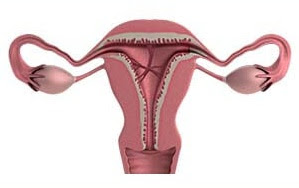Uterine Synechiae Meaning, Symptoms, Causes, Treatment
Uterine synechiae is a condition related to uterus in which adhesions are formed. The word synechiae means adhesion. These adhesions are like fibrous scars which are formed inside the cavity of uterus. Adhesions in uterus may occur due to uterine trauma like curettage and is also known as Asher man syndrome. Other causative factors involve caesarian section and myomectomy. Uterine adhesions during pregnancy are also referred as amniotic sheets and amniotic folds. These adhesions during pregnancy may lead to amenorrhea, hypo menorrhea, habitual abortion and secondary infertility. The diagnosis of these uterine synechiae is incidental during normal ultrasound evaluation during pregnancy.
Uterine synechiae do not cause any complications and also do not interfere in development and growth of fetus. These adhesions appear as thick bands attached to walls of uterus. A single synechiae have 2 parts i.e. 1 attached base and 1 free end. It is a combination of fibrous adhesions. Fetal membranes wrap the synechiae completely. Uterine synechiae have a complete classification according to its location and extension. Sometimes these lesions become worse and covers the whole cavity inside uterus causing the walls to stick together. Diagnosing the frequency of synechiae is not easy because it is asymptomatic in most cases.

Uterine synechiae are asymptomatic and only show symptoms when it gets worse with passing time because with every passing week, these adhesions covers the whole cavity inside uterus containing fetus. It often diagnosed during routine ultrasound checkup during pregnancy. These lesions may lead to various abnormal conditions like amenorrhea or really opposite condition i.e. loss of menstruation. Hypomenorrhea or scanty menstruation may also occur. Sometimes these uterine adhesions may cause infertility. Worse condition of uterine synechiae may cause recurrent abortion of fetus. All these conditions are secondary to adhesions in uterine walls.
There may be many causes behind formation of uterine synechiae. Some of the main causative factors are listed below.
Uterine synechiae can be treated with some surgical processes. Hysteroscopy is a diagnostic as well as surgical procedure with a camera placed ahead and used rarely to treat these uterine synechiae. Fertility is rarely effected by uterine synechiae but women are advised to take treatment option of in vitro fertilization. Especially after the age of 35. Uterine adhesions may alter transit of sperms during sexual intercourse and these will be no or abnormal pregnancy that’s why in vitro fertilization is recommended. Hysteroscopy should be performed as a minor surgery to continue with in vitro fertilization.
Uterine synechiae do not cause any complications and also do not interfere in development and growth of fetus. These adhesions appear as thick bands attached to walls of uterus. A single synechiae have 2 parts i.e. 1 attached base and 1 free end. It is a combination of fibrous adhesions. Fetal membranes wrap the synechiae completely. Uterine synechiae have a complete classification according to its location and extension. Sometimes these lesions become worse and covers the whole cavity inside uterus causing the walls to stick together. Diagnosing the frequency of synechiae is not easy because it is asymptomatic in most cases.

Uterine synechiae Symptoms
Uterine synechiae are asymptomatic and only show symptoms when it gets worse with passing time because with every passing week, these adhesions covers the whole cavity inside uterus containing fetus. It often diagnosed during routine ultrasound checkup during pregnancy. These lesions may lead to various abnormal conditions like amenorrhea or really opposite condition i.e. loss of menstruation. Hypomenorrhea or scanty menstruation may also occur. Sometimes these uterine adhesions may cause infertility. Worse condition of uterine synechiae may cause recurrent abortion of fetus. All these conditions are secondary to adhesions in uterine walls.
Uterine synechiae Causes
There may be many causes behind formation of uterine synechiae. Some of the main causative factors are listed below.
- Any kind of infection which may lead to fibrous adhesion in uterine walls.
- Long term use of intra uterine devices lead to infections due to aseptic conditions and these infections cause synechiae formation.
- These may be secondary to caesarian delivery of fetus and myomectomy.
- Surgical removal of myomas and polyps also lead to formation of adhesions in uterus.
- Any kind of trauma in uterus like curettage is the leading cause of uterine synechiae in females during pregnancy or after delivery.
Uterine synechiae Treatment
Uterine synechiae can be treated with some surgical processes. Hysteroscopy is a diagnostic as well as surgical procedure with a camera placed ahead and used rarely to treat these uterine synechiae. Fertility is rarely effected by uterine synechiae but women are advised to take treatment option of in vitro fertilization. Especially after the age of 35. Uterine adhesions may alter transit of sperms during sexual intercourse and these will be no or abnormal pregnancy that’s why in vitro fertilization is recommended. Hysteroscopy should be performed as a minor surgery to continue with in vitro fertilization.
Uterine Synechiae Meaning, Symptoms, Causes, Treatment
 Reviewed by Simon Albert
on
October 29, 2019
Rating:
Reviewed by Simon Albert
on
October 29, 2019
Rating:
 Reviewed by Simon Albert
on
October 29, 2019
Rating:
Reviewed by Simon Albert
on
October 29, 2019
Rating:











